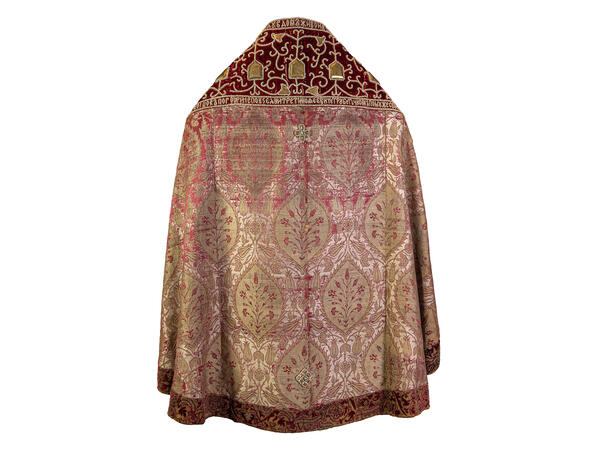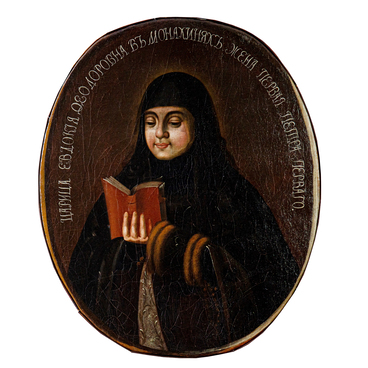The phelonion is the sleeveless outer vestment of an Orthodox priest. Jesus Christ wore such a garment, as confirmed by ancient icons, where the Savior is almost always depicted in a cloak, worn sometimes on both shoulders, and sometimes over one shoulder, which is how the first phelonions looked like. In ancient times, this garment was exclusively white, but over time it began to be made of fabric embroidered with gold or silver.
From the 15th-17th centuries, phelonions were often sewn from heavy gold brocade, so that their top rose in a cone above the shoulders. To make the top of a garment made of light fabrics look the same, they were made with a stiff lining.
This phelonion was presented to the the Trinity-St. Sergius Monastery by a representative of the ancient princely family Alexey Shein, an associate of Peter I. He was a talented military commander, won the battle of Azov and was the first in Russian history to receive the title of generalissimo. The boyar died in 1700, and according to his family tradition he was buried in the monastery of St. Sergius next to his father, the voivode (military governor).
During his lifetime, Prince Alexei Shein presented the ancient monastery with luxurious offerings. He gave the monastery the phelonion with a conventional image on the shoulder of a crowned double-headed eagle to a year before his death.
The complex composition was designed by a talented artist, then embroidered with precious materials in the princely workshop. In the time of Peter the Great, the symbols of the Russian Empire appeared in the ornaments of church vestments: royal crowns and double-headed eagles.
The phelonion is made of elegant brocade of Italian origin with a thick floral pattern. On the shoulder and on the hem there is embroidery imitating expensive gold lace. As a rule, the mistresses of the workshops took part in designing the item, and they often strung pearls and embroidered themselves.
In the Endowment Donation Book of the Trinity-St. Sergius Monastery there is a record:
From the 15th-17th centuries, phelonions were often sewn from heavy gold brocade, so that their top rose in a cone above the shoulders. To make the top of a garment made of light fabrics look the same, they were made with a stiff lining.
This phelonion was presented to the the Trinity-St. Sergius Monastery by a representative of the ancient princely family Alexey Shein, an associate of Peter I. He was a talented military commander, won the battle of Azov and was the first in Russian history to receive the title of generalissimo. The boyar died in 1700, and according to his family tradition he was buried in the monastery of St. Sergius next to his father, the voivode (military governor).
During his lifetime, Prince Alexei Shein presented the ancient monastery with luxurious offerings. He gave the monastery the phelonion with a conventional image on the shoulder of a crowned double-headed eagle to a year before his death.
The complex composition was designed by a talented artist, then embroidered with precious materials in the princely workshop. In the time of Peter the Great, the symbols of the Russian Empire appeared in the ornaments of church vestments: royal crowns and double-headed eagles.
The phelonion is made of elegant brocade of Italian origin with a thick floral pattern. On the shoulder and on the hem there is embroidery imitating expensive gold lace. As a rule, the mistresses of the workshops took part in designing the item, and they often strung pearls and embroidered themselves.
In the Endowment Donation Book of the Trinity-St. Sergius Monastery there is a record:



